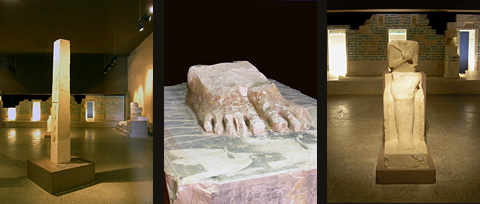Imhotep Museum
A new museum was opened at Saqqara in April 2006, named after Imhotep who is credited as the great architect of the Step Pyramid. The museum is found at the entrance to the archaeological site, next to the ticket office, in the new block of SCA buildings. Visitors are encouraged to go first to the visitor centre where they can see a nine minute National Geographic film about Saqqara and where a 3D model of the funerary complex is displayed. There is also a cafe and gift shop.

The Imhotep Museum is one of the new breed of Egyptian museums, spacious and with many well-lit objects beautifully displayed. In the entrance there is a library dedicated to the Egyptologist Jean-Philippe Lauer, who worked at Saqqara for much of his life, restoring many of the monuments we see there today. Sadly he died in 2001.

1 Boundary stele of Djoser with his Horus name of Netjerikhet. Saqqara, Dynasty III.
2 Statue base of Djoser with the name of Imhotep on the base. Dynasty III.
3 Seated statue of King Djoser, Dynasty III, from the Step Pyramid complex.
The large foyer displays the base of a statue of King Djoser, with part of his feet and the name, Imhotep, Chancellor of Lower Egypt written in hieroglyphs. Walking into the main hall, the eye is immediately drawn to a long wall opposite the entrance, covered in magnificent blue-green faience tiles collected from the burial chamber of Djoser’s pyramid and the South Tomb of the Step Pyramid complex. These have been reconstructed as a whole wall and include doorways with reliefs of the king running in the Heb-Sed. For me this is the showpiece of the whole museum. The rest of the room contains architectural elements, including the earliest examples of stone pillars and columns in their naturalistic style and the earliest stone arch. Imhotep is thought to have pioneered the use of stone in construction and he replicated the style of earlier elements of reeds and natural materials. In the centre of the main hall there are the remains of a seated statue of King Djoser.

To the left there is a room named Saqqara Tombs which contains many objects found in burials, including a reconstructed small tomb with a mummy. There are ceramic jars and shabtis, stone canopic jars, limestone mace-heads, jewellery and several small statue heads, wooden models from tombs and a large limestone sphinx of King Unas.

Here can also be found the haunting limestone reliefs from the causeway of Unas depicting starving Bedouin, thought to be replicas of those found on Sahure’s causeway and therefore a simple representation of hard times. Another block depicts part of the Pyramid Texts from the Pepi I Pyramid.

To the right of the main hall is a room named Saqqara Styles. Here we can see some of the beautiful Old Kingdom statues of familiar names such as Ptahshepses, Akhethotep and Ptahotep. There are stone vessels from the Early Dynastic Period, including some of the numerous bowls and jars which Djoser buried in his pyramid as relics of his ancestors. An Old Kingdom block relief nearby shows how stone jars were manufactured.

1 Statue of the vizier Ptahotep, from his tomb, Dynasty V.
2 Representation of a striding man, Saqqara, Dynasty V
3 Seated statue of a man, Old Kingdom.
The final room, Saqqara Missions, contains artefacts found in recent excavations at Saqqara. Among the most interesting objects are surgical tools and other burial goods from the tomb of the physician (or dentist) Qar, discovered recently in one of Dr Zahi Hawass’s excavations. In a case above these are about twenty Late Period bronze statues of gods and goddesses found near Qar’s tomb.

The Louvre’s Saqqara excavations are represented by colourful coffins and statuettes and there is also a brightly painted gilded coffin found in recent excavations around the Teti pyramid. This coffin dates to Dynasty XXX and though it is unnamed, it looks like it was painted yesterday.

There are many other stelae and statues, but the most exquisite must be the small limestone statue pair of Amenemipet and his wife, found at Saqqara on the Unas causeway. The Imhotep Museum is a tribute to Egypt’s new museums.
